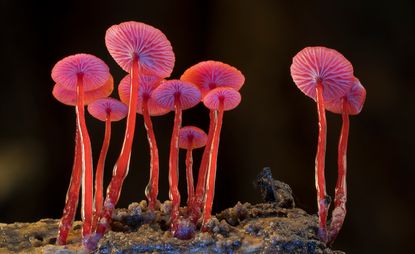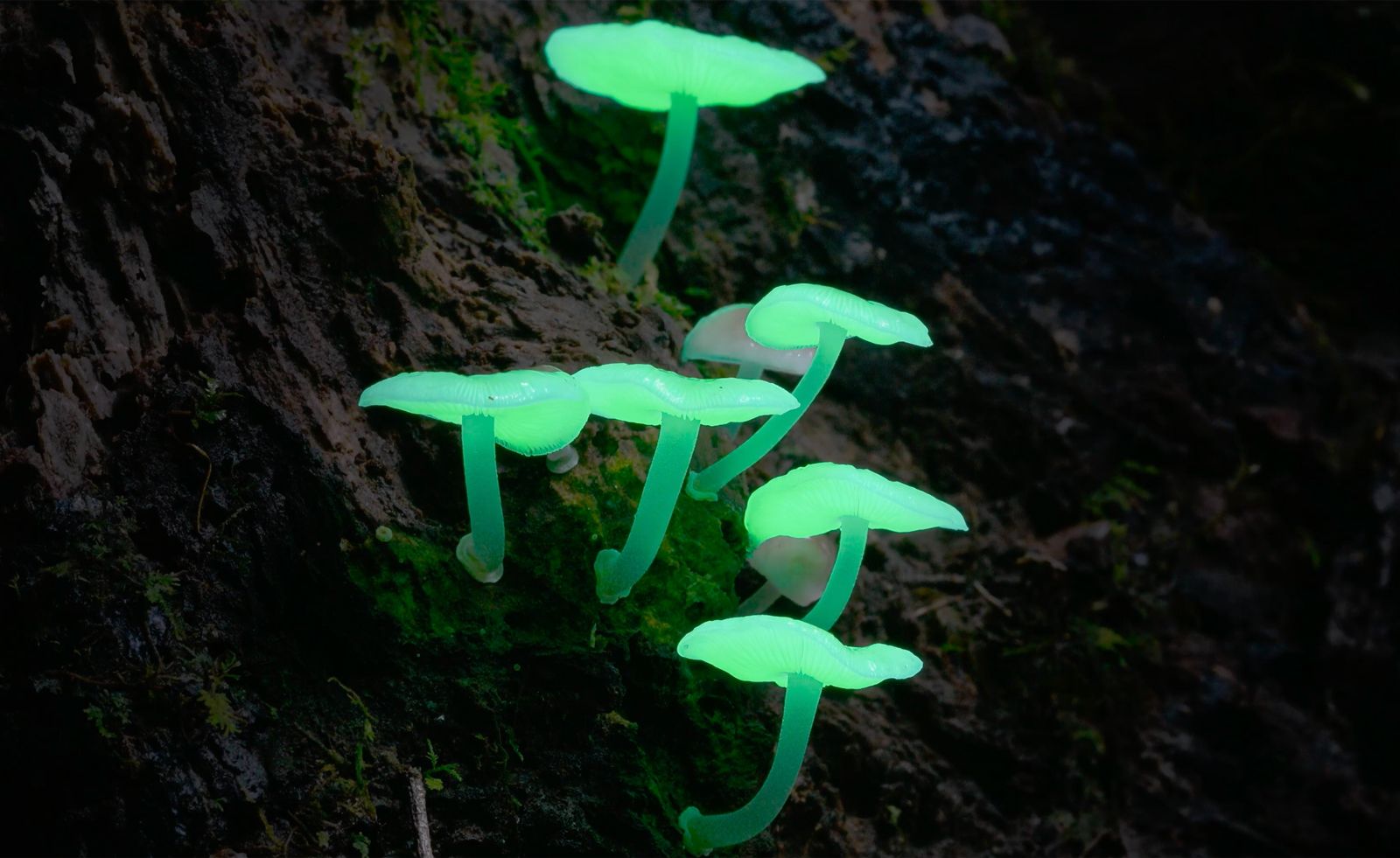‘Fungi: Web of Life’ film sees Björk and Merlin Sheldrake explore a magical world
Björk and microbiologist Merlin Sheldrake unite for ‘Fungi: Web of Life’, a 3D film in which the beauty and ecological importance of fungi unfurls

Björk has narrated a 3D film for IMAX about Fungi. Fungi: Web of Life, shot mostly in time-lapse, is presented by fungi expert Merlin Sheldrake and, with the Icelandic singer’s narration, lays bare how essential fungi is to the world we live in and how little we know about mycelial life.
'I am surprised by simple things, like how much how much fungal mycelium there is in a teaspoon of soil – between 100m and 10km,' says Sheldrake. 'It is a lot. These aren't just fungal cells that are just sitting there, they're doing stuff all the time, transforming their surroundings and producing chemicals that produce enzymes that are interacting with each other.'
Fungi: Web of Life – an ecological film narrated by Björk

Microbiologist Sheldrake has been making waves with his book, Entangled Life. It highlights the wonderful world of fungi from the mushrooms we see in forests, to the ones we eat, and the invisible world which exists all around us in everyday life. He was contacted by Australian production company Stranger Than Fiction, which produced the film, bringing together Sheldrake, Björk, and photographer Stephen Axford and filmmaker Catherine Marciniak, founders of Planet Fungi, who captured the stunning footage around which the film is based.
'I felt like a film about fungi would be fun and exciting,' explains Sheldrake, who has a PhD in tropical ecology from Cambridge University. 'They said that part of the plan was to work with Steve and Catherine, who create amazing time-lapses of growing mushrooms, so I said yes.'

Björk would join the project later in the process, adding her voice to the 3D unfurling beauty of the plants. 'Björk is such a strong artist and with such an expansive vision and a deeply held connection with the living world. It was a joy to work with her and that joy remains,' Sheldrake adds.
Known for her passionate support for the environment and nature, Björk joins Sheldrake in speaking on how the destruction of ancient forests also destroys the mycelial networks that connect plants under the ground. While fungi appear as mushrooms on the forest floor, or on the surface of plants and trees, they are also in the soil, connecting the roots of plants in what some call the ‘wood wide web’. The majority of the film takes place in Australia, in the ancient Tarkine Rainforest of Tasmania.
'[Featured] are pockets of forest which are like going back in time: they're the fragments of a type of rainforest that existed for millions of years, since the time of the dinosaurs. When you walk in these places, you are transported, so it was extraordinary to be there, shooting on location as part of such a wonderful team,' Sheldrake recalls. 'I was finding extraordinary fungi that I had never seen before, as a northern hemisphere person.'
Fungi and the forest: the ‘wood wibe web’

At the crux of the film is an ecological message, highlighting the fact that we don’t really know what it is that we are destroying as we extract resources from the Earth. 'The film’s purpose is also to draw attention to these forests and the plight of forests around the world, which are threatened by so many various extractive enterprises, as we know. So the story of the film is a journey through fungal life to explore what these organisms are, how they live, how they activate the regenerative capacity of the biosphere and how we can partner with them to adapt to life on a damaged planet,' continues Sheldrake.
The film also goes into the potential for certain species of fungi to do things like biodegrade plastics and grow the framework for new body organs. Such is the range of the potential for good from research into fungi that by the end of the 40-minute documentary, viewers are utterly converted to the change it could make.
It also gives Sheldrake more people to talk to about fungi. 'I feel like I can now talk to more people about my passion,' he says. 'But there is a more serious, larger point here, which is that fungi are such vital players in the Earth’s systems, and if we don't think about it, then we're missing a large part of the picture and our understanding of life is radically incomplete.'
Fungi: Web of Life is screening at the Bfi IMAX in London
Wallpaper* Newsletter
Receive our daily digest of inspiration, escapism and design stories from around the world direct to your inbox
Amah-Rose Abrams is a British writer, editor and broadcaster covering arts and culture based in London. In her decade plus career she has covered and broken arts stories all over the world and has interviewed artists including Marina Abramovic, Nan Goldin, Ai Weiwei, Lubaina Himid and Herzog & de Meuron. She has also worked in content strategy and production.
-
 Snailed it: Jessica McCormack and the Haas Brothers’ playful jewellery
Snailed it: Jessica McCormack and the Haas Brothers’ playful jewelleryJessica McCormack and the Haas Brothers give a second jewellery collaboration a swirl
By Hannah Silver Published
-
 Iné in Hampstead is a Japanese restaurant with a contemporary touch
Iné in Hampstead is a Japanese restaurant with a contemporary touchIné in London's Hampstead reflects edomae traditions, offering counter omakase and à la carte dining in a minimalist, contemporary setting
By Ellie Stathaki Published
-
 Jonathan Baldock’s playful works bring joy to Yorkshire Sculpture Park
Jonathan Baldock’s playful works bring joy to Yorkshire Sculpture ParkJonathan Baldock mischievously considers history and myths in ‘Touch Wood’ at Yorkshire Sculpture Park
By Anne Soward Published
-
 Heads up for London Film Festival 2023’s immersive art programme
Heads up for London Film Festival 2023’s immersive art programmeFrom VR fungi to AR walks, London Film Festival 2023 announces LFF Expanded, a compelling programme of immersive art and extended realities
By Tianna Williams Published
-
 John Waters on his weird and wonderful world, celebrated in new LA exhibition
John Waters on his weird and wonderful world, celebrated in new LA exhibitionThe cult filmmaker invites us into his studio ahead of ‘John Waters: Pope of Trash’, at LA’s Academy Museum of Motion Pictures (from 17 September)
By Hunter Drohojowska-Philp Published
-
 Asteroid City behind the scenes: How the world fell under Wes Anderson’s retro-tinted spell
Asteroid City behind the scenes: How the world fell under Wes Anderson’s retro-tinted spellWe peek behind the scenes of Wes Anderson’s new film Asteroid City, and explore how the world has gone barmy for the American filmmaker’s pastel-hued aesthetic
By Jessica Klingelfuss Last updated
-
 Steve McQueen to screen his harrowing film 'Grenfell' at London’s Serpentine
Steve McQueen to screen his harrowing film 'Grenfell' at London’s SerpentineAcclaimed film director and artist Steve McQueen will screen his film, Grenfell, at London’s Serpentine South gallery (7 April-10 May 2023), six years after the Grenfell Tower block blaze killed 72
By Harriet Lloyd-Smith Published
-
 Nan Goldin documentary is a gritty tale of addiction, resilience, and battles with the Sackler family
Nan Goldin documentary is a gritty tale of addiction, resilience, and battles with the Sackler familyAll the Beauty and the Bloodshed, directed by Laura Poitras chronicles acclaimed photographer Nan Goldin’s complex life, work, and tireless activism to hold power to account
By Harriet Lloyd-Smith Published
-
 Baz Luhrmann on creativity, that iconic scene in Romeo + Juliet, and collaborating with Bombay Sapphire
Baz Luhrmann on creativity, that iconic scene in Romeo + Juliet, and collaborating with Bombay SapphireWe speak to legendary film director and creative maestro Baz Luhrmann for the launch of ‘Saw This Made This’, his latest campaign with gin label Bombay Sapphire
By Jessica Klingelfuss Last updated
-
 Artist Julianknxx on poetry, dreams and Switzerland
Artist Julianknxx on poetry, dreams and SwitzerlandAhead of the New York showing of his major new film with Switzerland Tourism, we visit the studio of London-based poet and filmmaker Julianknxx
By Jessica Klingelfuss Last updated
-
 Huw Lemmey navigates sex, politics and espionage in new film
Huw Lemmey navigates sex, politics and espionage in new filmUngentle is a fictional journey through 20th-century Britain, exploring the relationship between espionage and male homosexuality. A collaboration between Huw Lemmey and Onyeka Igwe, the film is on view at London’s Studio Voltaire in September
By Davy Pittoors Last updated










